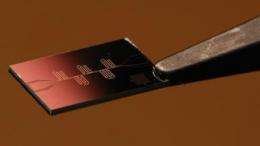Slowing down microwaves in a chip

EPFL scientists have succeeded in capturing a microwave pulse within a chip for several milliseconds before releasing it with little loss. This extraordinary delay normally requires hundreds of miles of electrical cable, as well as amplifiers.
Microwaves are ubiquitous: they are part of any cell phones or wireless routers. They are also used in navigation for airplanes and nowadays even in cars. The processing and management of microwave signals requires careful control over the way they propagate. As an example, to hold a microwave signal for a few milliseconds requires hundreds of miles of electrical cable and it causes deterioration in the quality of the wave being held up: it is therefore necessary to amplify the wave regularly as it propagates through the waveguide.
Together with the Walther-Meissner-Institute in Garching Germany, researchers from the Laboratory of Photonics and Quantum Measurements led by Tobias Kippenberg have developed a new approach for harnessing the propagation of microwave signals. Their conclusions are being published in Nature Physics.
A miniature vibrating bridge
Instead of using conventional electrical components such as capacitors or inductors, scientists use a nano-scale mechanical oscillator - a miniature vibrating bridge, 1000 times smaller than a human hair - to delay the microwave signals. This approach succeeded in holding an electromagnetic signal within a circuit for 3.5 milliseconds before releasing it on command, with negligible loss or distortions. This may seem very short, but it is a substantial amount of time in the microwave world. "Holding up a wave for 3.5 milliseconds before letting it propagate normally would require 600 kilometers of coaxial cable," says doctoral candidate Xiaoqing Zhou, lead author of the Nature Physics article. This was all done on a tiny chip measuring only 6mm by 10mm.
Towards a hybrid technology
A combination of two devices - a hybrid technology - drives the performance improvement of the new system. The circuit holds a microwave cavity, which looks like a miniature S-shape conductor (see image on right), and a nano-mechanical oscillator (see image below), a tiny vibrating string, which is positioned inside the micro-cavity. A signal that reaches the micro-cavity is reflected around the interior boundaries of the cavity thousands of times. In this way it stays within the device for a short period. The nano-mechanical oscillator allows the cavity to hold the wave even longer. In this way, the two technologies combine to "hold" the wave for several milliseconds. The key point is that the loss of the nanomechanical oscillator is much lower than the electrical components; this increases the performance of the device, allowing long storage times.
Work as an all microwave-transistor
More precisely, in practice when a signal arrives in the circuit an additional strong microwave (pump) is used to help to boost the power of the oscillations produced naturally by the nanomechanical oscillator. A reciprocal phenomenon subsequently occurs: the oscillations, which were driven by the microwave, reciprocally provoke a change in the microwave signal itself. In this way, each element in the system affects the other elements: the signal affects the mechanical oscillator, and the oscillator affects the signal, allowing delaying, advancing or switching of microwave pulses. "By adjusting the pump, one can decide to slow down the signal, to speed it up or even to block it or let it go", says Xiaoqing Zhou. The circuit can be used for classical signals, but also for quantum signals – signals that are very faint and follow the often counter-intuitive laws of quantum mechanics.
Suitable for both classical and quantum systems
The device was produced entirely within the EPFL's Center of MicroNanoTechnology (CMI). For the moment, it only works at very low temperatures- only a tiny bit above absolute zero, due to the fact that the microwave circuit is made from a superconducting material. But the principle could equally be used to develop devices that operate at room temperature.
More information: Full-text article in Nature Physics.
Journal information: Nature Physics
Provided by Ecole Polytechnique Federale de Lausanne


















